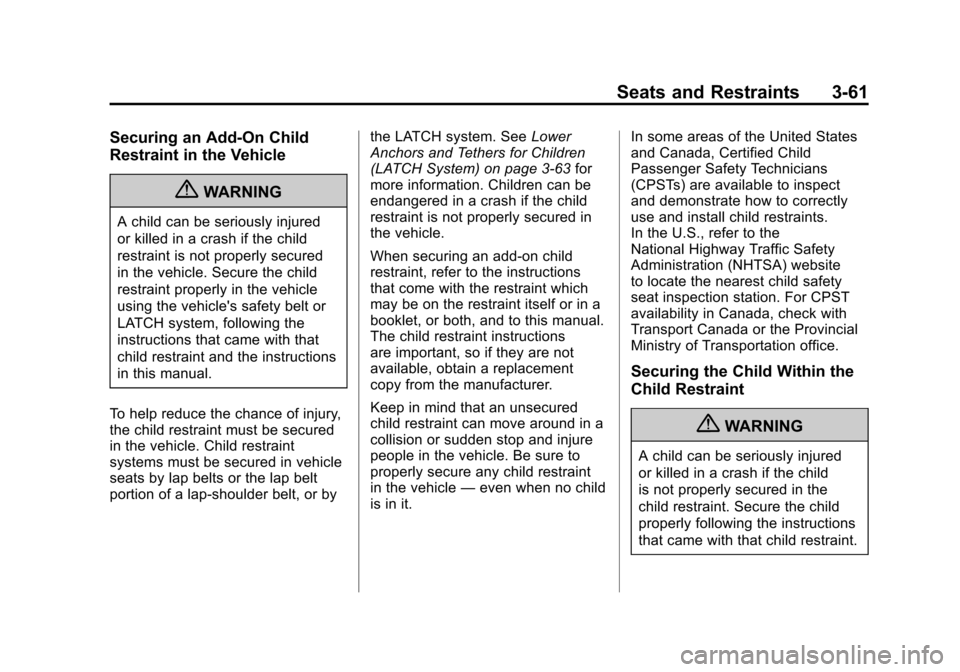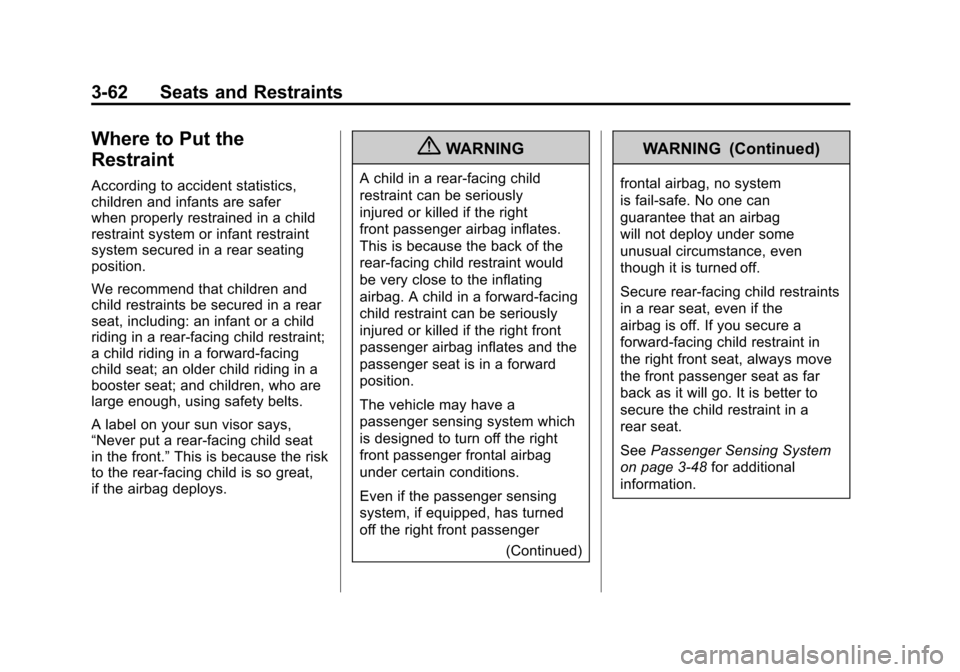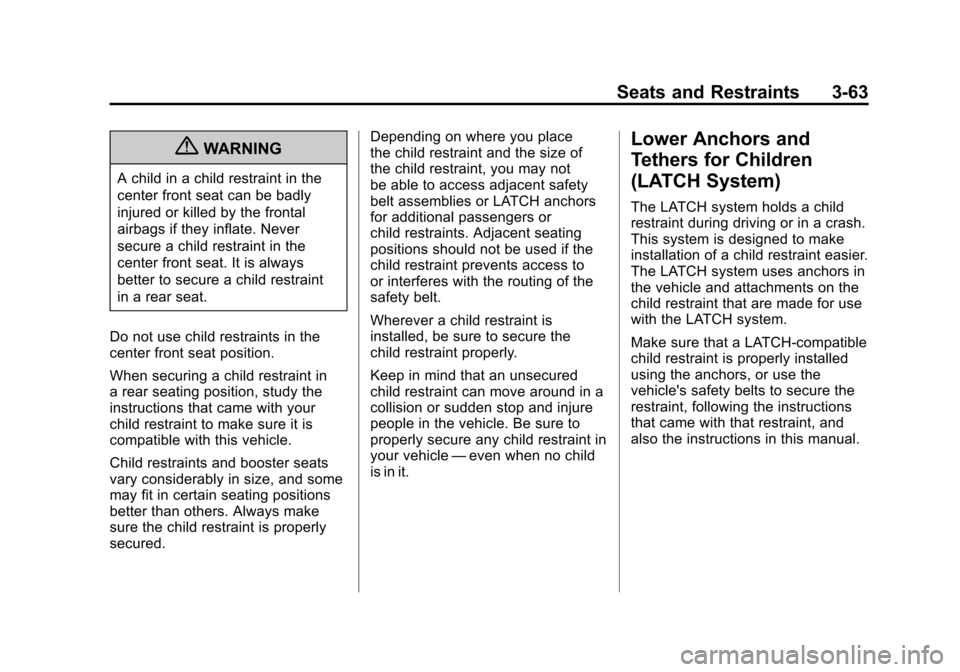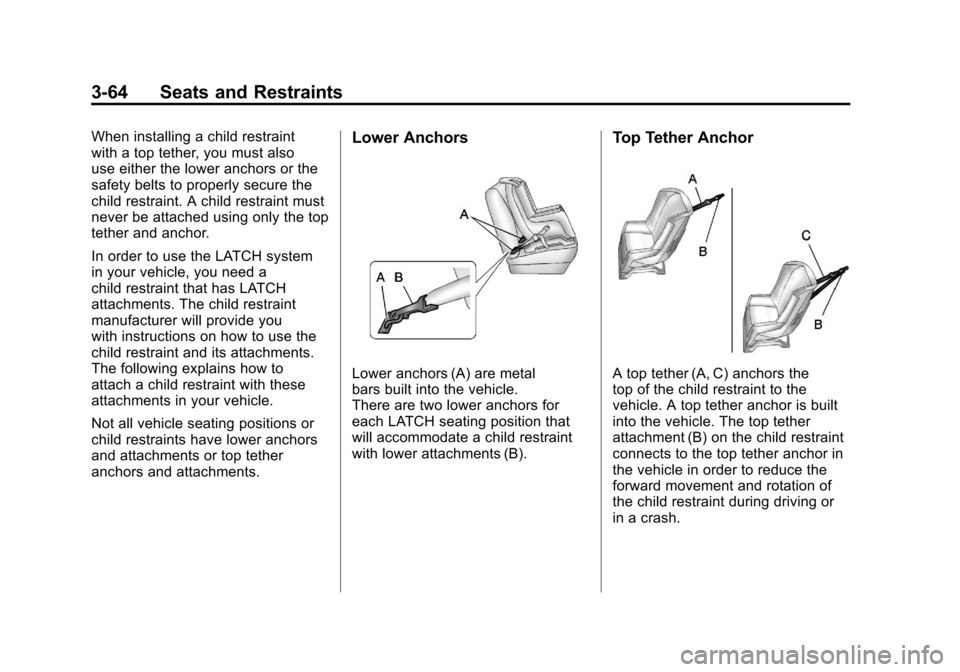Page 116 of 558
Black plate (60,1)Cadillac Escalade/Escalade ESV Owner Manual - 2011
3-60 Seats and Restraints
Child Restraint Systems
(A) Rear‐Facing Infant Seat
A rear-facing infant seat (A)
provides restraint with the seating
surface against the back of the
infant.
The harness system holds the infant
in place and, in a crash, acts to
keep the infant positioned in the
restraint.
(B) Forward-Facing Child Seat
A forward-facing child seat (B)
provides restraint for the child's
body with the harness.(C) Booster Seats
A booster seat (C) is a child restraint
designed to improve the fit of the
vehicle's safety belt system.
A booster seat can also help a
child to see out the window.
Page 117 of 558

Black plate (61,1)Cadillac Escalade/Escalade ESV Owner Manual - 2011
Seats and Restraints 3-61
Securing an Add-On Child
Restraint in the Vehicle
{WARNING
A child can be seriously injured
or killed in a crash if the child
restraint is not properly secured
in the vehicle. Secure the child
restraint properly in the vehicle
using the vehicle's safety belt or
LATCH system, following the
instructions that came with that
child restraint and the instructions
in this manual.
To help reduce the chance of injury,
the child restraint must be secured
in the vehicle. Child restraint
systems must be secured in vehicle
seats by lap belts or the lap belt
portion of a lap-shoulder belt, or by the LATCH system. See
Lower
Anchors and Tethers for Children
(LATCH System) on page 3‑63 for
more information. Children can be
endangered in a crash if the child
restraint is not properly secured in
the vehicle.
When securing an add-on child
restraint, refer to the instructions
that come with the restraint which
may be on the restraint itself or in a
booklet, or both, and to this manual.
The child restraint instructions
are important, so if they are not
available, obtain a replacement
copy from the manufacturer.
Keep in mind that an unsecured
child restraint can move around in a
collision or sudden stop and injure
people in the vehicle. Be sure to
properly secure any child restraint
in the vehicle —even when no child
is in it. In some areas of the United States
and Canada, Certified Child
Passenger Safety Technicians
(CPSTs) are available to inspect
and demonstrate how to correctly
use and install child restraints.
In the U.S., refer to the
National Highway Traffic Safety
Administration (NHTSA) website
to locate the nearest child safety
seat inspection station. For CPST
availability in Canada, check with
Transport Canada or the Provincial
Ministry of Transportation office.
Securing the Child Within the
Child Restraint
{WARNING
A child can be seriously injured
or killed in a crash if the child
is not properly secured in the
child restraint. Secure the child
properly following the instructions
that came with that child restraint.
Page 118 of 558

Black plate (62,1)Cadillac Escalade/Escalade ESV Owner Manual - 2011
3-62 Seats and Restraints
Where to Put the
Restraint
According to accident statistics,
children and infants are safer
when properly restrained in a child
restraint system or infant restraint
system secured in a rear seating
position.
We recommend that children and
child restraints be secured in a rear
seat, including: an infant or a child
riding in a rear-facing child restraint;
a child riding in a forward-facing
child seat; an older child riding in a
booster seat; and children, who are
large enough, using safety belts.
A label on your sun visor says,
“Never put a rear-facing child seat
in the front.”This is because the risk
to the rear-facing child is so great,
if the airbag deploys.
{WARNING
A child in a rear-facing child
restraint can be seriously
injured or killed if the right
front passenger airbag inflates.
This is because the back of the
rear-facing child restraint would
be very close to the inflating
airbag. A child in a forward-facing
child restraint can be seriously
injured or killed if the right front
passenger airbag inflates and the
passenger seat is in a forward
position.
The vehicle may have a
passenger sensing system which
is designed to turn off the right
front passenger frontal airbag
under certain conditions.
Even if the passenger sensing
system, if equipped, has turned
off the right front passenger
(Continued)
WARNING (Continued)
frontal airbag, no system
is fail-safe. No one can
guarantee that an airbag
will not deploy under some
unusual circumstance, even
though it is turned off.
Secure rear-facing child restraints
in a rear seat, even if the
airbag is off. If you secure a
forward-facing child restraint in
the right front seat, always move
the front passenger seat as far
back as it will go. It is better to
secure the child restraint in a
rear seat.
SeePassenger Sensing System
on page 3‑48 for additional
information.
Page 119 of 558

Black plate (63,1)Cadillac Escalade/Escalade ESV Owner Manual - 2011
Seats and Restraints 3-63
{WARNING
A child in a child restraint in the
center front seat can be badly
injured or killed by the frontal
airbags if they inflate. Never
secure a child restraint in the
center front seat. It is always
better to secure a child restraint
in a rear seat.
Do not use child restraints in the
center front seat position.
When securing a child restraint in
a rear seating position, study the
instructions that came with your
child restraint to make sure it is
compatible with this vehicle.
Child restraints and booster seats
vary considerably in size, and some
may fit in certain seating positions
better than others. Always make
sure the child restraint is properly
secured. Depending on where you place
the child restraint and the size of
the child restraint, you may not
be able to access adjacent safety
belt assemblies or LATCH anchors
for additional passengers or
child restraints. Adjacent seating
positions should not be used if the
child restraint prevents access to
or interferes with the routing of the
safety belt.
Wherever a child restraint is
installed, be sure to secure the
child restraint properly.
Keep in mind that an unsecured
child restraint can move around in a
collision or sudden stop and injure
people in the vehicle. Be sure to
properly secure any child restraint in
your vehicle
—even when no child
is in it.
Lower Anchors and
Tethers for Children
(LATCH System)
The LATCH system holds a child
restraint during driving or in a crash.
This system is designed to make
installation of a child restraint easier.
The LATCH system uses anchors in
the vehicle and attachments on the
child restraint that are made for use
with the LATCH system.
Make sure that a LATCH-compatible
child restraint is properly installed
using the anchors, or use the
vehicle's safety belts to secure the
restraint, following the instructions
that came with that restraint, and
also the instructions in this manual.
Page 120 of 558

Black plate (64,1)Cadillac Escalade/Escalade ESV Owner Manual - 2011
3-64 Seats and Restraints
When installing a child restraint
with a top tether, you must also
use either the lower anchors or the
safety belts to properly secure the
child restraint. A child restraint must
never be attached using only the top
tether and anchor.
In order to use the LATCH system
in your vehicle, you need a
child restraint that has LATCH
attachments. The child restraint
manufacturer will provide you
with instructions on how to use the
child restraint and its attachments.
The following explains how to
attach a child restraint with these
attachments in your vehicle.
Not all vehicle seating positions or
child restraints have lower anchors
and attachments or top tether
anchors and attachments.Lower Anchors
Lower anchors (A) are metal
bars built into the vehicle.
There are two lower anchors for
each LATCH seating position that
will accommodate a child restraint
with lower attachments (B).
Top Tether Anchor
A top tether (A, C) anchors the
top of the child restraint to the
vehicle. A top tether anchor is built
into the vehicle. The top tether
attachment (B) on the child restraint
connects to the top tether anchor in
the vehicle in order to reduce the
forward movement and rotation of
the child restraint during driving or
in a crash.
Page 121 of 558
Black plate (65,1)Cadillac Escalade/Escalade ESV Owner Manual - 2011
Seats and Restraints 3-65
Your child restraint may have
a single tether (A) or a dual
tether (C). Either will have a single
attachment (B) to secure the top
tether to the anchor.
Some child restraints with top
tethers are designed for use with
or without the top tether being
attached. Others require the top
tether always to be attached.
In Canada, the law requires that
forward-facing child restraints have
a top tether, and that the tether
be attached. Be sure to read and
follow the instructions for your
child restraint.Lower Anchor and Top Tether
Anchor Locations
Second Row—60/40
j(Lower Anchor): Seating
positions with two lower anchors.
i(Top Tether Anchor): Seating
positions with top tether anchors.
Second Row —Bucket
j(Lower Anchor): Seating
positions with two lower anchors.
i(Top Tether Anchor): Seating
positions with top tether anchors.
Page 122 of 558

Black plate (66,1)Cadillac Escalade/Escalade ESV Owner Manual - 2011
3-66 Seats and Restraints
Third Row Seat
i(Top Tether Anchor): Seating
positions with top tether anchors.
There is one top tether anchor that
can be used for either the third row
center or driver side seating position
but not both at the same time. For models with a third row seat,
see the information following for
installing a child restraint with a top
tether in the third row, if your vehicle
has one. Never install two top
tethers using the same top tether
anchor.
For models with 60/40 second
row seating, the rear right side
passenger and center seating
positions have exposed metal
anchors located in the crease
between the seatback and the
seat cushion.
For models with second row bucket
seats, both rear seating positions
have exposed metal anchors
located in the crease between the
seatback and the seat cushion.
Second Row Seat
—Bucket
For models with bucket second
row seating, the top tether anchors
are located at the bottom rear of
the seat cushion for each seating
position in the second row. Be sure
to use an anchor located on the
same side of the vehicle as the
seating position where the child
restraint will be placed.
Page 123 of 558

Black plate (67,1)Cadillac Escalade/Escalade ESV Owner Manual - 2011
Seats and Restraints 3-67
Second Row Seat—60/40
For models with 60/40 second row
seating, the top tether anchors are
located at the bottom rear of the
seat cushion for each seating
position in the second row. Be sure
to use an anchor located on the
same side of the vehicle as the
seating position where the child
restraint will be placed.Third Row Seat
For vehicles with a third row seat,
there is one top tether anchor
located at the bottom rear of the
seat cushion that can be used for
either the third row center or driver
side seating position. Never install
two top tethers using the same top
tether anchor. Do not secure a child restraint in a
position without a top tether anchor
if a national or local law requires
that the top tether be attached, or if
the instructions that come with the
child restraint say that the top tether
must be attached.
According to accident statistics,
children and infants are safer when
properly restrained in a child
restraint system or infant restraint
system secured in a rear seating
position. See
Where to Put the
Restraint on page 3‑62 for
additional information.